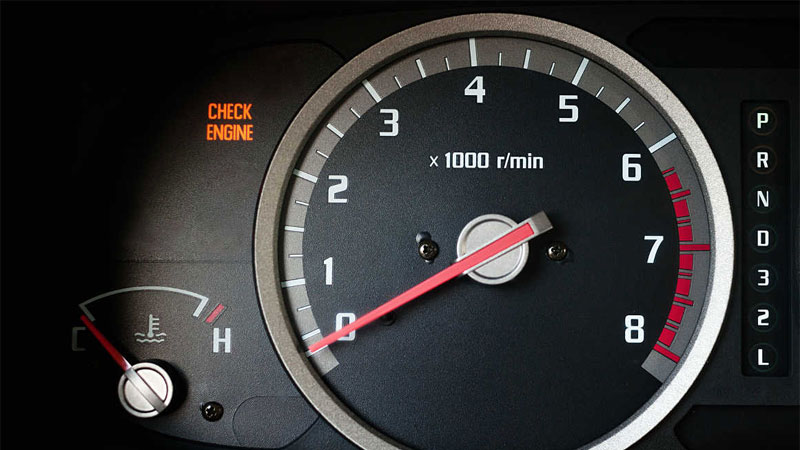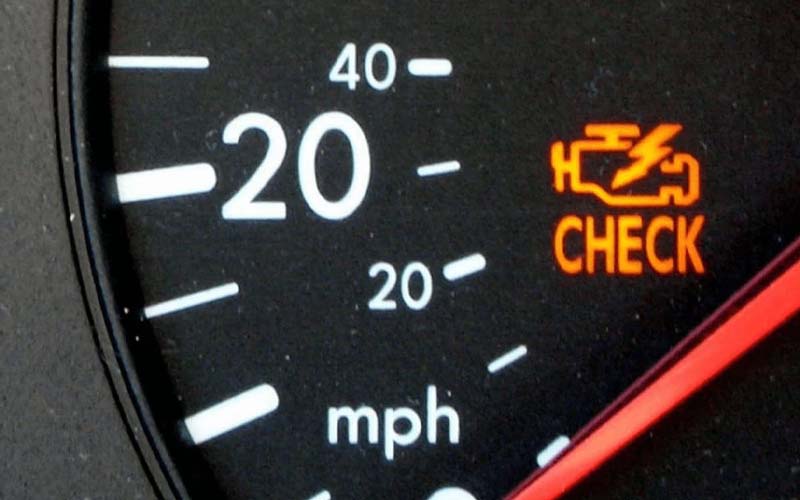Many drivers may have come up with the question: the check engine is flashing. What does the check engine light mean? Read on to find a more specific answer.
If it continues to run, something is wrong. If your check engine light flashes or blinks instead of remaining illuminated, there is a serious issue that needs to be fixed right away.
The check engine light (typically a yellow or orange outline of an engine with the word “Check” or “Service Engine”) should come on for a few seconds every time you start the engine with other warning lights.
A check engine light may illuminate for a number of common reasons that are straightforward to fix, but occasionally it indicates a more serious issue.
What is a Check Engine Light?
Depending on the seriousness of the vehicle problem, the check engine light may flash or remain on.
For most car owners, car light symbols such as a check engine light suddenly appearing can be frustrating and confusing to understand.
So that you can avoid wasting money and worrying needlessly, we’ve put together this list of tips to assist you in determining the most likely causes.
Using a diagnostics tool is the best way for non-mechanics to turn off your engine light.
Are you prepared to understand the check engine light? Let’s go!

Decipher the Code
Some motorists might mistake the check engine light for the service or maintenance required light on the instrument cluster. There is no connection between these alert lights. The service required light simply indicates that the vehicle needs an oil change or other standard maintenance. The check engine light is an indicator of trouble, but this light is not.
The diagnosis typically takes an hour of labor from your neighborhood mechanic. However, there is a method to speculate on what the issue might be. Do-it-yourselfers can buy inexpensive code readers from an auto parts store or online that connect to the onboard diagnostics (OBD) port and search for the code’s meaning on websites such as Engine Light Help. The code will be displayed by modern systems in a smartphone app.
Read about Why is My Check Engine Light Flashing?
Handle Check Engine Light on Like a Pro
Look for a Serious Problem
Check your dashboard symbols and dashboard lights for indications of low oil pressure or overheating. These issues require immediate attention.
Therefore, if you see them, stop when it’s safe to do so and turn off the engine.
Faulty Gas Cap
The engine light may illuminate as a result of a loose, harmed, or missing gas cap. By evaporating fuel, a broken gas cap will result in fuel loss and more expensive trips to the gas station.
This is because a gas cap is responsible for:
- Sealing the fuel system
- Helping maintain pressure within the fuel tank
- Preventing release of gasoline / petrol fumes (hydrocarbons) into the atmosphere
You can frequently resolve the issue and turn off the engine light by simply tightening or replacing a loose gas cap.
Bad Catalytic Converter
A catalytic converter turns harmful carbon monoxide from a car’s exhaust into carbon dioxide. primarily to aid in preserving our environment.
A faulty catalytic converter will cause your vehicle to:
- Fail the emissions test
- Suffer reduced car performance and fuel economy
- Run at a higher temperature
The check engine light will turn off once you replace the catalytic converter if that is the cause of the problem.
Bad Oxygen Sensor
The amount of unburned oxygen in your car’s exhaust system is measured by the oxygen sensor. A faulty one means:
- Your car engine will burn more fuel than needed
- Lost fuel economy as you’ll cover fewer kilometres per litre
- Faulty sensors can damage your car’s spark plugs and catalytic converter
The engine light on your dashboard will turn off when a bad oxygen sensor is replaced.
Faulty Spark Plugs Or Spark Plug Wires
The air/fuel mixture in your car’s combustion chamber is ignited by spark plugs. However, spark plug wires are responsible for transferring the spark from the ignition coil to the spark plugs.
Worn out spark plugs and spark plug wires can result in :
- Poor car performance
- Reduced engine power
- Poor fuel economy
- Clogged catalytic converter
- destruction of the oxygen sensor and ignition coils.
Your engine light will turn on if they need to be replaced if they are defective.

Mass Airflow Sensor
Your engine’s mass airflow sensor measures how much air it receives. The amount of fuel required to run your car engine effectively can then be calculated.
A faulty mass airflow sensor can cause:
- Your catalytic converter, oxygen sensors, or spark plugs are damaged.
- Reduced car performance
- Reduced fuel economy
Engine Overload
Your car’s performance may suffer and its power may be reduced when the engine is under load, such as when towing a trailer. Reduce your speed and the load on the engine in this situation.
After that, have your car inspected to prevent further damage.
Turn Off the Check Engine Light
The majority of code readers let you reset or turn off the check engine light. But this action alone doesn’t actually solve the underlying issue. Often, the light will just turn on again later.
Mixed Signals
Even if you are mechanically inclined, as we learned from one of our colleagues, a DIY interpretation can be a little challenging even with the code and its meaning in hand.
His wife’s car started acting up, and the check engine light came on. His code reader picked up a code for the cam angle sensor. He considered purchasing the sensor and doing the setup himself. But if he had, he would have wasted time and money because it turned out the sensor was fine. Instead, mice had accessed the hood from underneath and had chewed on some of the wires leading to it.
What Could Cause the Check Engine Light to Come On?
CarMD, an automotive telematics company, publishes an annual The top 10 most frequent check engine light codes are listed along with the approximate repair costs in the Vehicle Health Index. For 2022, CarMD’s top 10 check engine codes are:
- Replace catalytic converter(s) with new OEM catalytic converter(s) $1,355.78
2. Replace oxygen sensor(s) $242.87
3. Replace ignition coil(s) and spark plug(s): $387.47
4. Replace mass airflow sensor: $319.02
5. Inspect for loose fuel cap and tighten or replace: $24.77
6. Replace ignition coil(s): $214.43
7. Replace fuel injector(s): $420.25
8. Replace evaporative emissions (EVAP) purge control valve: $140.73
9. Replace thermostat: $235.42
10. Replace evaporative emissions (EVAP) purge solenoid: $146.64
Steve Mazor, a retired chief automotive engineer for the Auto Club of Southern California, said that occasionally, the check engine light will illuminate even though there is nothing wrong with the vehicle. A change in humidity or other factors might be the cause of a transient issue. In these circumstances, the light ought to turn off on its own after a brief period.
Don’t Ignore That Light
According to Mazor, some people panic when they notice the check engine light. “They just put a piece of black tape over the dashboard light and keep driving,” he said. Mazor points out, however, that it’s crucial to tackle any issues that the light flags as soon as possible. Ignoring them now could result in later, more serious issues that are more expensive.
Mazor advises the driver to examine the gas cap if the light illuminates. A leak in the vapor recovery system, one component of an automobile’s emissions system, is reported by a loose gas cap in an error message sent to the computer of the vehicle. Tighten the fuel cap if necessary and keep driving. Nevertheless, he warns that the light won’t turn off right away.
What should you do if the check engine light is steady rather than flashing when it first appears? The simplest solution is to have the engine examined by a mechanic, but you might be tempted to ignore it if you know that a steady light poses less of an immediate threat than a flashing one. In fact, a lot of people choose to do nothing, possibly out of concern for a high repair bill. Some motorists may want to get as many miles out of their older vehicles as they can without stopping at a repair shop.
However, you must have the check engine light extinguished before your vehicle can pass your state’s inspection the following time it is required. Additionally, a state inspection is a strong incentive to address the issue. In the end, the relationship between the engine and the emission control system is so strong that it serves as a reliable indicator of the overall condition of the car’s engine.
If you love chandeliers but have recessed lights in your home, we’ll show you how to convert a recessed light to a pendant.
Types of Engine Light
We can all agree that if your engine light comes on, your car’s performance isn’t up to par. What sort of issue is this, though? Let’s dig deeper.
Steady light: It means there is a problem, but it is not an emergency. However, you should make a reservation with a skilled service technician as soon as possible. Don’t wait for the issue to get worse and do more harm.
Blinking light: It indicates a severe engine misfire. Both the vehicle’s safety and emissions output are impacted. Unburned fuel can leak into the exhaust system as a result of this misfire.
The catalytic converter’s temperature can quickly rise to a point where damage is likely as a result of the unburned fuel being dumped into the engine. And that can only indicate an expensive auto repair.
What to do? The engine of your car may be seriously damaged if the engine light is flashing continuously. At the closest safe location, turn off the engine and have your car inspected.
Beware that modern automotive computers attempt to make up for problems.
And as a result, you might not notice your car’s declining performance even though your fuel economy is suffering and your car is emitting too many pollutants, like hydrocarbons, at an unacceptable level.
The service interval or maintenance reminder light should not be confused with the check engine light.
Due to the fact that they are activated by mileage or fuel consumption, these lights will always come on when a service is due.
Problem Fixed?
As we’ve seen, you or a mechanic can both fix all of these car problems. It should go without saying that you can tighten a slack gas cap.
You may, however, need to take your car to a mechanic for some issues, who will read and decipher the diagnostic trouble codes using a scan tool.
Want to give it a shot? Okay, but there is one (possible) issue: the code testing procedure must be carried out in strict order. A process can be rendered useless by skipping some tests or carrying out steps out of order.
It doesn’t matter how close it is. Frustrating, right?



